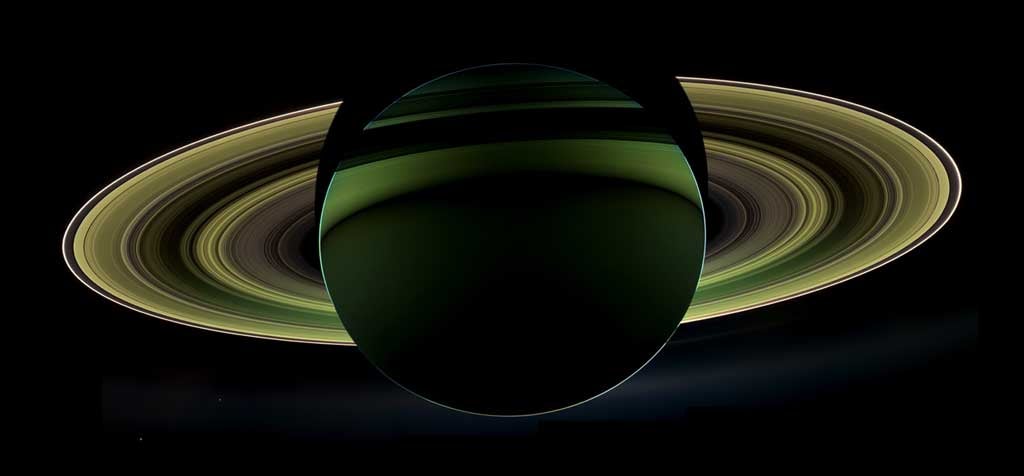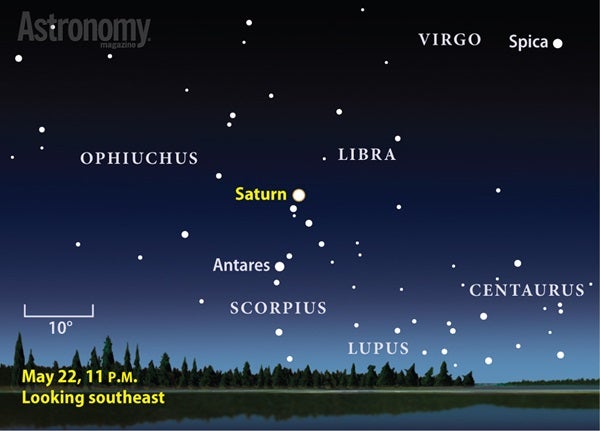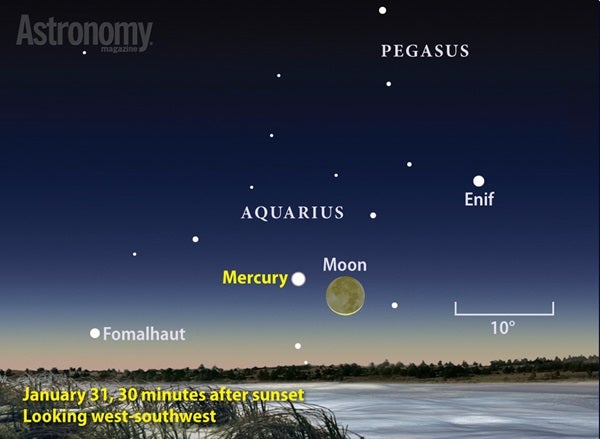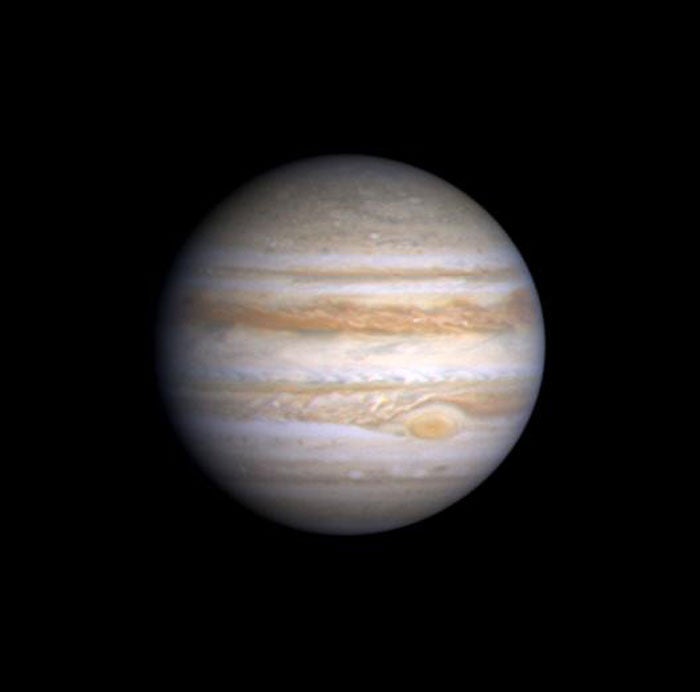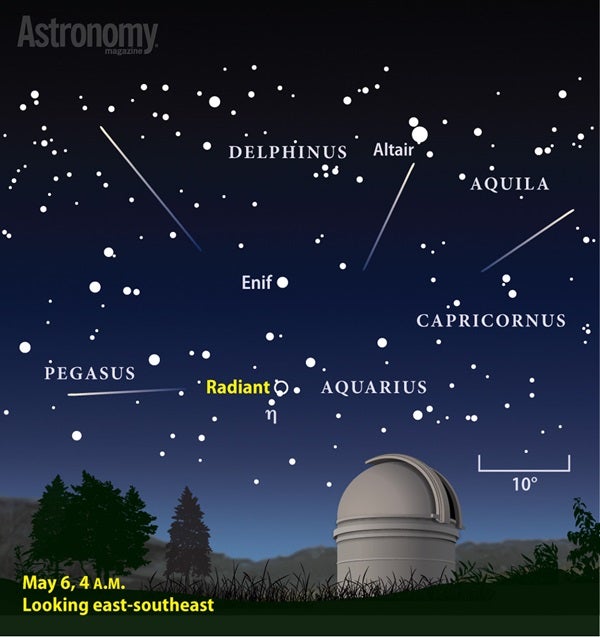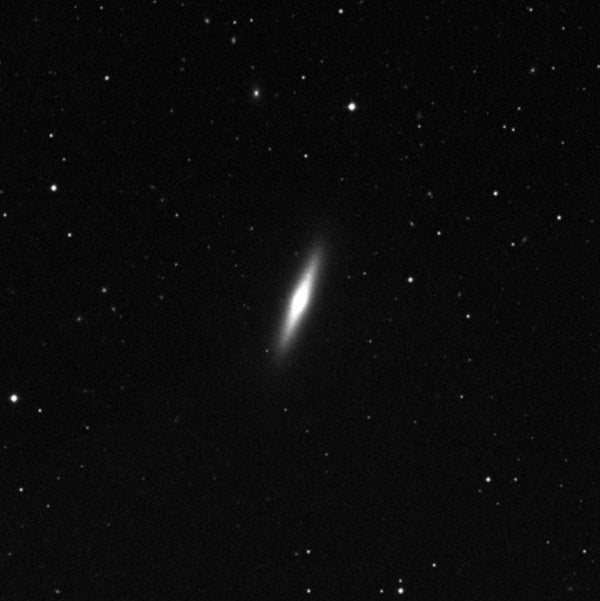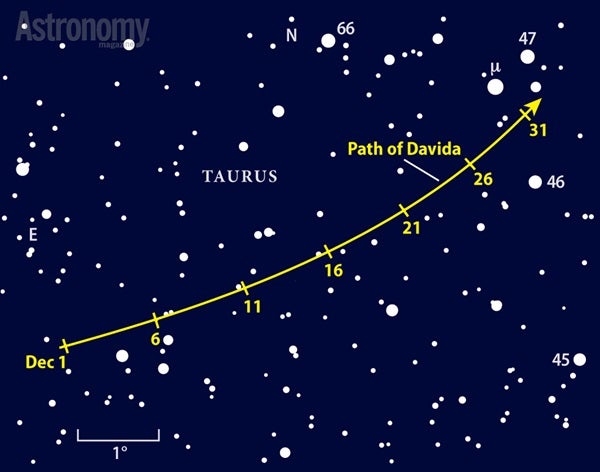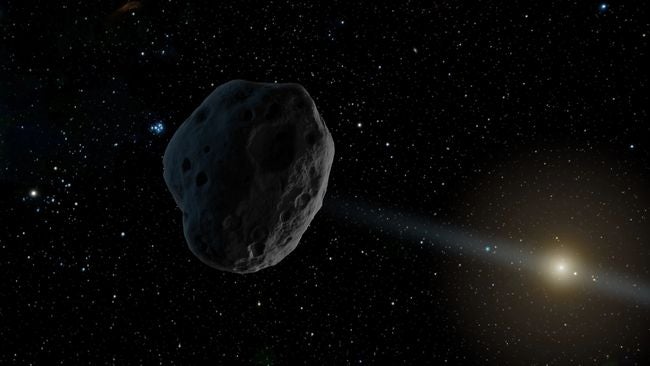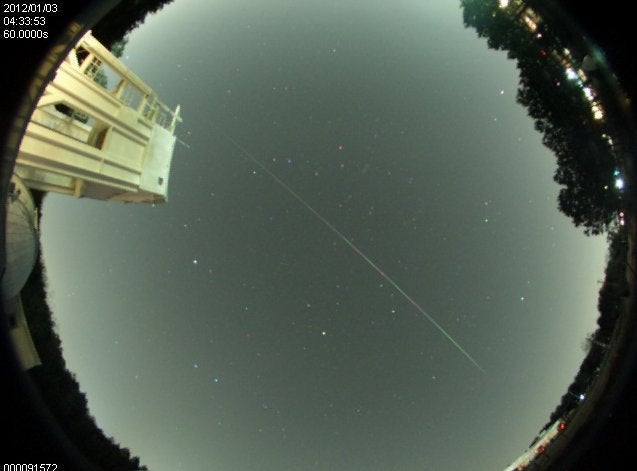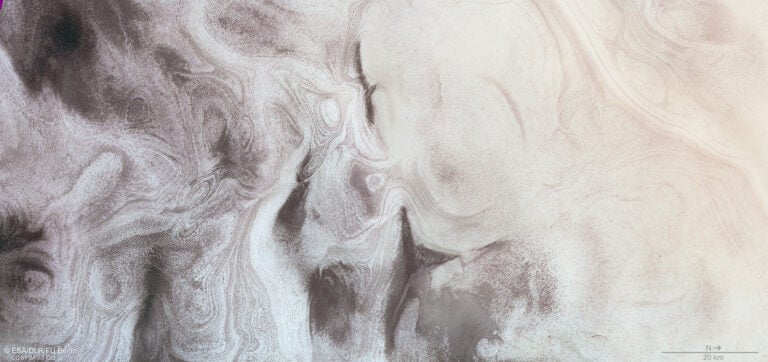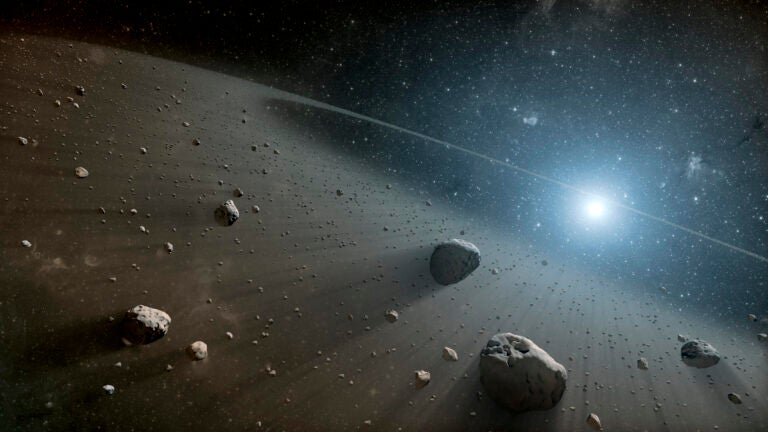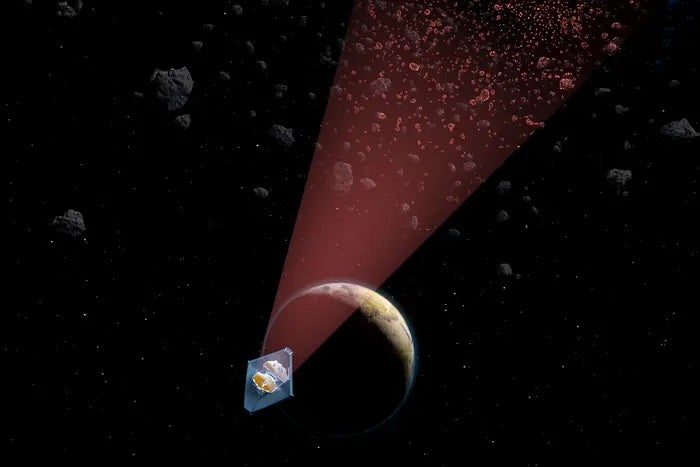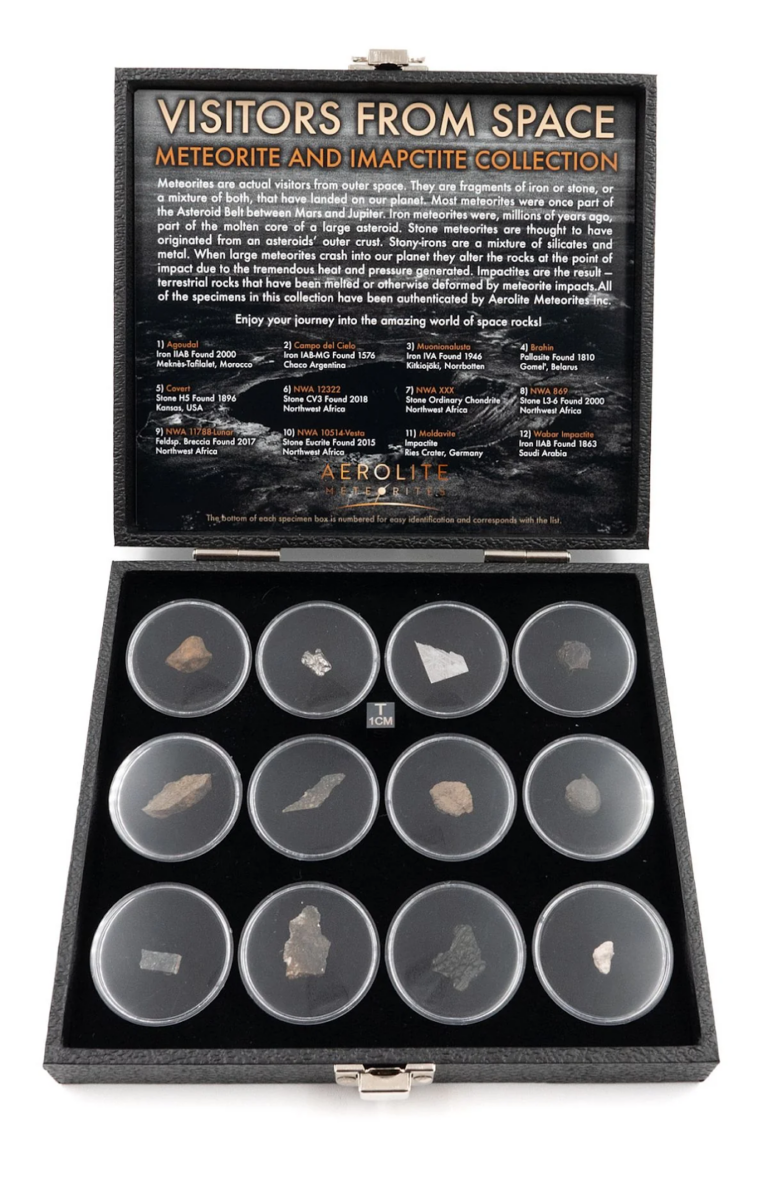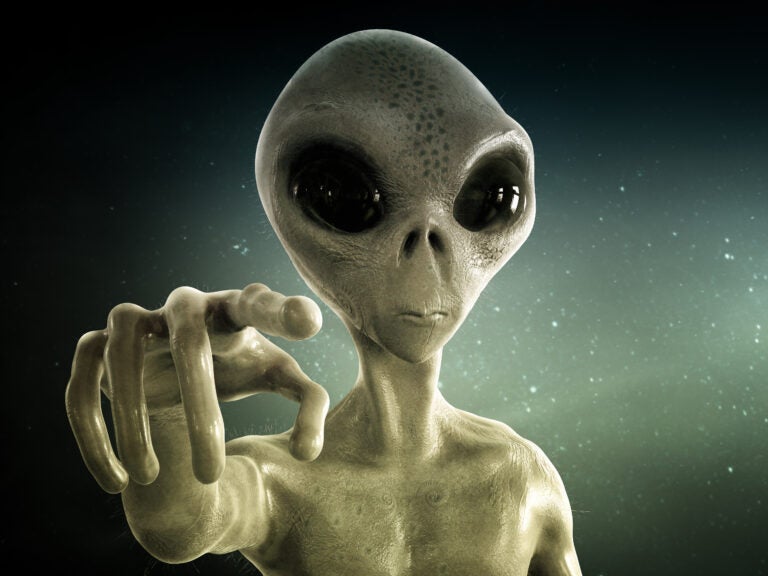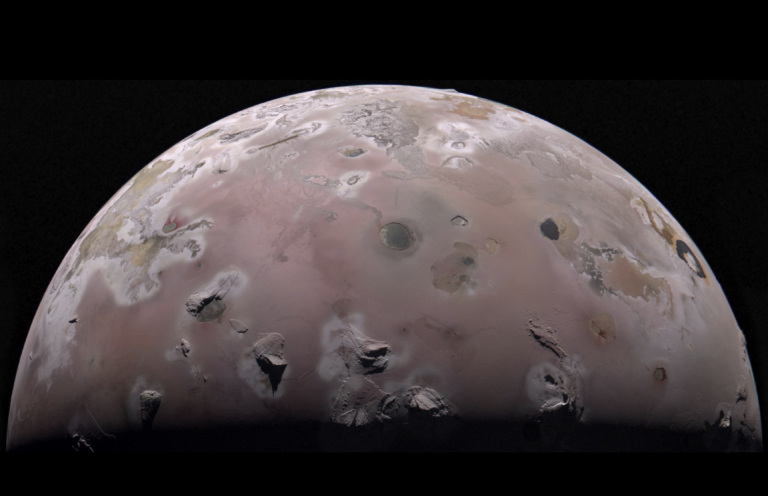The planetary action gets underway shortly after the Sun sets May 1. Scan the area above the west-northwestern horizon about 45 minutes after sundown, and you should spy Mercury. The inner planet shines brightly at magnitude –0.4 and shows up quite easily in the fading twilight. If you don’t see it at first with your naked eyes, binoculars will make it obvious. Binoculars also should reveal the gorgeous Pleiades star cluster (M45) just 2° northwest of the planet.
Mercury reaches greatest elongation the evening of May 6, when it lies 21° east of the Sun and stands 11° above the horizon 45 minutes after sunset. Although it has dimmed to magnitude 0.2, it appears more prominent than on the 1st thanks to its greater height. This date marks the planet’s peak evening altitude of the year for those at mid-northern latitudes. A telescope reveals a disk that spans 8″ and appears slightly more than one-third lit.
Unfortunately, Mercury’s appearance doesn’t last long. The planet continues to fade as it falls back into brighter twilight. It glows at magnitude 1.0 on the 11th when it passes 8° north (to the upper right) of similarly bright Aldebaran, Taurus’ brightest star. Mercury disappears from view just a week later.
As you hunt for Mercury, you can’t help but notice a far brighter object lurking higher in the west. Venus dominates the evening sky, shining at magnitude –4.2 in early May and brightening to magnitude –4.4 by month’s end. On the 1st, it sits squarely between Beta (β) and Zeta (ζ) Tauri, the stars that mark the horns of Taurus the Bull.
Observers who target Venus through a telescope this month will notice significant changes. The planet’s apparent diameter grows from 17″ to 22″ while the phase diminishes from 67 to 53 percent lit.
Jupiter is the second brilliant planet on display in May’s evening sky. The planet shines at magnitude –2.1 on the 1st and dims to magnitude –1.9 by the 31st. It spends the month against the backdrop of eastern Cancer, though the Crab’s faint stars prove no match for the solar system world.
Although Jupiter sets after midnight local daylight time, it rides highest in the west during early evening. That’s the time to grab your telescope and get crisp views of the planet’s wonderfully detailed atmosphere.
Jupiter’s equator spans 36″ in mid-May, a value that changes only slightly during the course of the month. Because the gas giant spins so rapidly — completing a rotation in less than 10 hours — its equatorial diameter is some 2″ greater than its polar diameter. This equatorial bulge shows up clearly through small telescopes. Also prominent are the planet’s two dark equatorial belts. If you watch carefully, more subtle atmospheric features will pop into view.
Perhaps the most thrilling occurs the night of May 27/28 when Ganymede eclipses Io while the two moons’ shadows appear to merge on Jupiter’s cloud tops. East Coast observers will want to start watching as soon as twilight falls. The run-up to the event begins when Io starts transiting Jupiter at 8:49 p.m. EDT. Nine minutes later, Ganymede’s shadow begins its transit.
Innermost Io orbits the planet faster than Ganymede, so the former crosses the jovian disk faster than the latter’s shadow. Once Io’s shadow enters the disk at 10:01 p.m. EDT, the race is on. The shadows are due to merge starting at 11:38 p.m., although they likely will blur together some minutes before.
Ganymede also starts eclipsing Io at 11:38 p.m., when both objects stand clear of Jupiter’s western limb. The eclipse lasts 22 minutes, and at its peak, Io will appear some 40 percent dimmer than it normally does. It will take another few minutes after this mutual event wraps up for the moons’ shadows to separate clearly. Io’s shadow leaves the planet at 12:18 a.m. followed 16 minutes later by Ganymede’s shadow.
Saturn comes up around 9:30 p.m. local daylight time May 1, but it takes at least an hour for it to climb comfortably above the southeastern horizon. It lies among the background stars of Scorpius, 1.2° due north of the 2nd-magnitude double star Beta Scorpii. Saturn shines at magnitude 0.1, a full magnitude brighter than the Scorpion’s luminary, Antares, which lies 10° away.
But in reality, Saturn looks great all month. Its size May 1 is a nearly imperceptible 0.8 percent smaller than at opposition. A much bigger viewing factor is its altitude. As with any planet, you want to observe Saturn when it lies highest in the sky — around 2:30 a.m. local daylight time May 1 and two hours earlier at month’s close. The dark Cassini Division that separates the outer A ring from the brighter B ring stands out through any telescope.
Saturn also has a family of moons, though only 8th-magnitude Titan shows up through the smallest scopes. You’ll find it due north of Saturn on May 3 and 19 and due south May 10/11 and 26/27. A 4-inch instrument typically reveals three additional moons orbiting inside Titan. Tethys, Dione, and Rhea shine at 10th magnitude and change positions noticeably each night.
The final bright moon is distant Iapetus, which glows at 10th magnitude when it reaches greatest western elongation May 19/20. It then stands 9′ from Saturn, a far greater distance than any of the other moons. You’ll find Iapetus 2.5′ southwest of Saturn on May 1, but it then appears a magnitude fainter than it does three weeks later.
Mercury, Venus, Jupiter, and Saturn will keep observers busy throughout the month. And that’s a good thing because the other planets pale in comparison. Neptune rises around 3 a.m. local daylight time in mid-May and appears low in the southeast before dawn. You’ll need binoculars or a telescope to spot its 8th-magnitude glow some 2.2° southwest of Lambda (λ) Aquarii.
Uranus rises during twilight during most of May. By the end of the month, it appears a couple of degrees above the eastern horizon as dawn starts to break, though its 6th-magnitude glow will be hard to see without excellent sky conditions. Both it and Neptune will improve in June.
Mars currently lies hidden on the far side of the Sun from Earth. It will return to view in late summer.
Just south of the lunar equator in the Moon’s eastern hemisphere lies an unusual pair of craters: Messier and Messier A. Two bright rays radiate from this doublet’s western component, Messier A. The craters were named in honor of the famed 18th-century French comet hunter Charles Messier because the rays resemble a comet’s tail.
The nearly Full Moon in early May offers good crater viewing, but the observing window closes on the 6th as the Sun sets over the region. When sunrise returns May 21, the low Sun angle exaggerates the topography. Increase magnification to 100x or more, and you’ll see that the craters appear distinctly out-of-round compared with others nearby. Wait another night or two to see the rays stretching westward. The higher Sun then emphasizes the contrast between the bright rays and the darker lava of Mare Fecunditatis (the Sea of Fertility).
The rays’ origin puzzled astronomers for centuries. Clarity finally came in 1978 when Don Gault and John Wedekind announced results from their experiments at NASA’s Ames Vertical Gun Ballistic Range. The scientists shot small pellets at different targets at speeds up to 15,000 mph. They discovered how craters and their splashes of debris change shape depending on the impact angle.
The researchers managed to create a double crater using just one pellet. Messier’s formation now made sense: A fast-moving projectile whacked the Moon from the east at a grazing angle and then skipped once. This created a pair of side-by-side oval craters and sprayed debris in the projectile’s direction of motion.
The Eta Aquariid meteor shower is one of two annual showers that result from Earth crossing the orbital path of Comet 1P/Halley (the other is October’s Orionids). As our planet plows into dust particles shed by the comet over many millennia, the bits burn up in the upper atmosphere and create a display of “shooting stars.”
The Eta Aquariid shower peaks the morning of May 6. Unfortunately, a waning gibbous Moon shares the sky and will drown out fainter meteors. For the best views, find an otherwise dark spot and place a tree or building between you and the Moon. With clear weather and some luck, you might spot up to 10 meteors in the hour before dawn. It’s a far cry from the normal rate (up to 55 per hour), but it’s the best May has to offer.
| WHEN TO VIEW THE PLANETS |
||
| Evening Sky |
Midnight | Morning Sky |
| Mercury (northwest) |
Jupiter (west) |
Saturn (southwest) |
| Venus (west) |
Saturn (southeast) |
Uranus (east) |
| Jupiter (southwest) |
Neptune (southeast) |
|
| Saturn (southeast) |
|
|
| |
||
Across the decades, observers with 6- to 8-inch scopes under dark May skies have seen hundreds of distant galaxies and dozens of relics from the birth of our solar system we call comets. But this month, it appears none of those solar system entities will brighten enough to make a worthy target. We’ll likely have to wait a couple of months for a decent one. In the meantime, it pays to keep your skills sharp on a comet pretender.
During his evening and predawn comet-seeking vigils, renowned observer David Levy would stop and pay extra attention whenever he swept up a legitimate prospect. NGC 4570 in Virgo is Levy’s look-alike No. 326, as cataloged in his book Deep Sky Objects: The Best and Brightest from Four Decades of Comet Chasing.
Glowing at magnitude 10.9, typical for an undiscovered comet in the 1980s, NGC 4570 doesn’t look right for a galaxy. Ellipticals tend to be nearly round, while spirals typically sport sharper edges or mottled faces caused by dust lanes. Classified as an S0 galaxy, NGC 4570 is a fairly featureless object that can masquerade as an inbound comet thanks to its smooth appearance and elongated shape. The galaxy’s middle features a bright, nearly stellar dot that looks similar to a comet’s false nucleus, the shroud of dust that obscures the actual surface.
How do you tell the difference between a look-alike and the real thing? Bump up the magnification, and take a closer look at the object’s shape and how its light drops off at the edges. A comet often has a sharp border on its sunward side and a diffuse one on the other, but even an expert can be deceived if the dust tail spreads out directly behind the comet’s head. A comet-seeker must record an object’s position precisely and then wait to see if it moves.
If NGC 4570 is not real enough, try viewing Comet Lovejoy (C/2014 Q2) near Polaris. You’ll likely need a 10-inch or larger scope to pull in its feeble glow, which astronomers think may reach only 12th magnitude this month.
Asteroid 532 Herculina reaches opposition May 17, but the 9th-magnitude object is easy to track down all month. It resides among the background stars of Serpens Caput, a region that lies in the southeast after darkness falls and climbs highest in the south after midnight. Begin your search with magnitude 3.7 Epsilon (ε) Serpentis, which lies a few degrees north of Herculina’s path.
This asteroid offers a chance to try different styles of asteroid hunting. If you’re the impatient sort and just want to see the glowing dot before moving on, observe near the middle or end of May, when Herculina shines brighter than any star near its track. Particularly around the 17th, the space rock passes in front of galactic dust clouds that block much of the background starlight.
To see the asteroid shift positions during a three- or four-hour session, try the evenings of May 4, 10, or 21, when it passes within 3′ of a field star. If you prefer the classic method — making a sketch of four or five stars and seeing which one shifts from one night to the next — May 4–7 is perfect while the 10th–12th and 25th–27th are observer friendly, too.
Martin Ratcliffe provides planetarium development for Sky-Skan, Inc. from his home in Wichita, Kansas. Meteorologist Alister Ling works for Environment Canada in Edmonton, Alberta.

